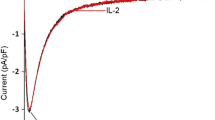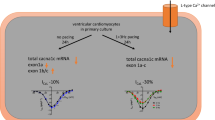Abstract
The regulation of L-type voltage-dependent Ca2+ channels by chronic depolarization was studied in the aortic smooth muscle A7r5 and neuron-type PC12 cell lines, by probing the expression and the functional state of their constitutive α-1 subunits. PC12 cells showed, after prolonged exposure to a high-K+ depolarizing solution, a 25% reduction of the functional Ca2+ channel density which was accompanied by a decrease of the α-1 subunit mRNA expression. In A7r5 cells submitted to a similar protocol of depolarization, 45Ca2+ uptake measurements revealed a fall in the functional activity of L-type Ca2+ channels which was not related to a modulation of their mRNA expression, but arose from a long-term voltage-dependent channel inactivation. Accordingly, the lag time and the mechanisms of recovery were different in the two cell types. In PC12 cells, when restoring physiological culture conditions, de novo synthesis of α-1 subunits allowed the recovery of the original density of L-type Ca2+ channels at the membrane surface. As for the A7r5 cells, we showed that after chronic depolarization, the complete restoration of the resting membrane potential and the related Ca2+ channel activity required a 2-day incubation in physiological medium and could probably be related to a normalization of the increased intracellular Ca2+ concentration. In contrast, it is noteworthy that, in PC12 cells, the only transient increase of intracellular Ca2+ content in the first hours of depolarization could account for the long-term down-regulation of L-type Ca2+ channels.
Similar content being viewed by others

References
Alps BJ (1992) Drugs acting on calcium channels: potential treatment for ischaemic stroke. Br J Clin Pharmacol 34:199–206
Auffray C, Rougeon F (1979) Purification of mouse immunoglobulin heavy-chain messenger RNAs from total myeloma tumor RNA. Eur J Biochem 107:303–314
Chelly J, Kaplan J-C, Maire P, Gautron S, Kahn A (1988) Transcription of the dystrophin gene in human muscle and non-muscle tissues. Nature 333:858–860
Chien KR, Abrams J, Serroni A, Martin JT, Farber JL (1978) Accelerated phospholipid degradation and associated membrane dysfunction in irreversible, ischemic liver cell injury. J Biol Chem 253:4809–4817
De Clerck F, David JL (1981) Pharmacological control of platelet and red blood cell function in microciruculation. J Cardiovasc Pharmacol 3:1388–1412
Delorme EM, Rabe CS, McGee R (1988) Regulation of the number of functional voltage-sensitive Ca2+ channels on PC12 cells by chronic changes in membrane potential. J Pharmacol Exp Ther 244: 838–843
Di Virgilio F, Milani D, Leon A, Meldolesi J, Pozzan T (1987) Voltage-dependent activation and inactivation of Ca2+ channels in PC12 cells: correlation with neurotransmitter release. J Biol Chem 262:9189–9195
Feron O, Octave JN, Christen MO, Godfraind T (1994) Quantification of two splicing events in the L-type Ca2+ channel alpha-1 subunit of intestinal smooth muscle and other tissues. Eur J Biochem 222:195–202
Ferrante J, Triggle DJ, Rutledge A (1991) The effects of chronic depolarization on L-type 1,4-dihydropyridine-sensitive voltage-dependent Ca channels in chick neural retina and rat cardiac cells. Can J Physiol Pharmacol 69:914–920
Godfraid T, De Pover A, Verbeke N (1977) Influence of pH and sodium on the inhibition of guinea-pig heart (Na+, K+)-ATPase by calcium. Biochim Biophys Acta 481:202–211
Godfraind T, Miller R, Wibo M (1986) Calcium antagonists and calcium entry blockade. Pharmacol Rev 38:321–416
Greenberg DA, Carpenter CL, Messing RO (1986) Depolarization-dependent binding of the calcium cahnnel antagonist (+)-[3H]-PN 200 110 to intact cultured PC12 cells. J Pharmacol Exp Ther 238:1021–1027
Greene LA, Tischler AS (1976) Establishment of a noradrenergic clonal line of rat adrenal pheochromocytoma cells which respond to nerve growth factor. Proc Natl Acad Sci USA 73:2424–2428
Grohovaz F, Zacchetti D, Clementi E, Lorenzon P, Meldolesi J, Fumagali G (1991) [Ca2+]i imaging in PC12 cells: multiple response patterns to receptor activation reveal new aspects of transmembrane signaling. J Cell Biol 113:1341–1350
Hall ED, Wolf DL (1986) A pharmacological analysis of the pathophysiological mechanisms of posttraumatic spinal cord ischemia. J Neurosurg 64:951–961
Hayashi T, Nakai T, Miyabo S (1991) Glucocorticoids increase Ca2+ uptake and [3H]-dihydropyridine binding in A7r5 vascular smooth muscle cells. Am J Physiol 261:C106-C114
Hladovec J, De Clerck F (1981) Protection by flunarizine against endothelial injury in vivo. Angiology 32:448–462
Kanazawa T, Morita T, Harada K, Iwamoto T, Ohtaka H, Sukamoto T, Ito K, Nurimoto S (1990) Selective effect of KB-2796 a new calcium entry blocker on cerebral circulation:a comparative study of the effects of calcium entry blockers on cerebral and peripheral arteries blood flows. J Cardiovasc Pharmacol 16:430–437
Kimes BW, Brandt BL (1976) Characterization of two putative smooth muscle cell lines from rat thoracic aorta. Exp Cell Res 98:349–366
Kirino T (1982) Delayed neuronal death in the gerbil hippocampus following ischemia. Brain Res 239:57–69
Kloner RA, Braunwald E (1987) Effects of calcium antagonists on infarcting myocardium. Am J Cardiol 59:84B-89B
Lichtshtein D, Kaback HR, Blume AJ (1979) Use of lipophilic-cation for determination of membrane potential in neuroblas-toma-glioma hybrid cell suspensions. Proc Natl Acad Sci USA 76:650–654
Lowry OH, Rosebrough NJ, Farr AL, Randall RJ (1959) Protein measurement with the Folin phenol reagent. J Biol Chem 193:265–275
Malbon CC, Hadcock JR, Rapiejko PJ, Ros M, Wang HY, Watkins DC (1990) Regulation of transmembrane signalling elements: transcriptional post-transcriptional and post-translational controls. Biochem Soc Symp 56:155–164
Marks TN, Dubyak GR, Jones SW (1990) Calcium currents in the A7r5 smooth muscle-derived cell line. Pflügers Arch 417:433–439
McCormack JG (1985) Characterization of the effects of Ca2+ on the intramitochondrial Ca2+-sensitive ennzymes form rat liver and within intact rat liver mitochondria. Biochem J 231:581–595
Morel N, Godfraind T (1987) Prolonged depolarization increases the pharmacological effect of dihydropyridines and their binding affinity for calcium channels of vascular smooth muscle. J Pharmacol Exp Ther 217:711–715
Murphy JG, Marsh JD, Smith TW (1987) The role of calcium in ischemic myocardial injury. Circulation 75 [supp 15]: 15–24
Navarro J (1987) Modulation of [3H]-dihydropyridine receptors by activation of protein kinase C in chick muscle cells. J Biol Chem 262:4649–4652
Nayler WG, Sturrock WJ (1985) Inhibitory effect of calcium antagonists on the depletion of norephinephrine during post ischemic reperfusion. J Cardiovasc Pharmacol 7:581–587
Nguyen VT, Morange M, Bensuade O (1988) Firefly luciferase luminescence assays using scintillation counters for quantitation in transfected mammalian cells. Anal Biochem 171:404–408
Parys JB, Missiaen L, De Smedt H, Casteels R (1993) Loading dependence of inositol 1,4,5-triphophate-induced Ca release in the clonal cell line A7r5: implication for the mechanism of quantal Ca2+ release. J Biol Chem 268:25206–25212
Peeters T (1986) Calcium in physiological and pathological cell function. Eur Neurol 25:27–44
Saido TC, Sorimachi H, Suzuki K (1994) Calpain: new perspectives in molecular diversity and physiological-pathological involvement. FASEB J 8:814–822
Siesjo BK (1988) Historical overview: calcium ischaemia and death of brain cells. Ann NY Acad Sci 522:638–661
Skattebol A, Brown AM, Triggle DJ (1989) Homologous regulation of voltage-dependent calcium channels by 1,4-dihydropyridines. Biochem Biophys Res Commun 160:929–936
Sperti G, Colucci WS (1987) Phorbol ester stimulated bidirectional transmembrane calcium flux in A7r5 vascular smooth muscle cells. Mol Pharmacol 32:37–42
Tan K-N, Tashjian AH Jr (1984) Voltage-dependent calcium channel in pituitary cells in culture: characterization by 45Ca2+ fluxes. J Biol Chem 259:418–426
Toll L (1982) Calcium antagonists:high-affinity binding and inhibition of Ca2+ transport in a clonal cell line. J Biol Chem 257:13189–13192
Wei XY, Rutledge A, Triggle DJ (1989) Voltage-dependent binding of 1,4-dihydropyridine Ca2+ channel antagonists and activators in cultured neonatal rat ventricular myocytes. Mol Pharmacol 35:541–552
Wibo M, De Roth L, Godfraind T (1988) Pharmacologic relevance of dihydropyridine binding sites in membrane from rat aorta:kinetic and equilibrium studies. Circ Res 62:91–96
Wieloch T, Siesjo BK (1982) Ischemic brain injury:the importance of calcium, lipolytic activities and free fatty acids. Pathol Biol 5:269–277
Author information
Authors and Affiliations
Rights and permissions
About this article
Cite this article
Feron, O., Godfraind, T. Regulation of the L-type calcium channel α-1 subunit by chronic depolarization in the neuron-like PC12 and aortic smooth muscle A7r5 cell lines. Pflügers Arch 430, 323–332 (1995). https://doi.org/10.1007/BF00373906
Received:
Revised:
Accepted:
Issue Date:
DOI: https://doi.org/10.1007/BF00373906



